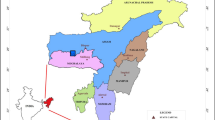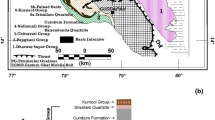Abstract
An integrated gravity–magnetic study has been carried out over Madawara Igneous Complex (MIC) in southern part of Bundelkhand Craton with an aim to decipher shallow crustal configuration and mineralized zones, thereby to improve the understanding of tectonic evolution of the region. Derived gravity and magnetic anomaly maps show good correlation with known geology and have delineated continuity of mafic–ultramafic intrusive bodies in EW direction. Radially averaged power spectrum (2D) and solutions derived from 3D Euler deconvolution have revealed average basement depths for gravity sources as ~0.3, 1.2 and 3.2 km, whereas for magnetic sources as ~0.3 and 1.2 km. From this study, these interfaces could be attributed to sedimentary origin for shallowest layer, mafic–ultramafic intrusive for intermediate layer and changes within the granite–gneissic basement for deeper solutions. Two-dimensional inverse modelling of residual gravity anomaly has delineated intrusion of highly dense mafic–ultramafic rocks from deeper part within the granite gneissic complex. Deeper basement from gravity and shallower from magnetic data indicate presence of two-stage magmatism within a subduction setting where the second magmatic emplacement probably occurred with a magma that comprises high magnetic material. High gravity and magnetic anomalies are observed over the mafic and ultramafic rock samples which are already identified (based on previous geochemical studies) as prospective zones for Cr, Ni and PGE mineralization. Thus, it can be inferred from this study that the mafic–ultramafic intrusive bodies are favourable targets for Cr–Ni–PGE mineralisation which may be obtained between a depth range of around 300 m to 3 km. Thus, the study enhances the scope for further integrated geophysical investigation over the identified prospective zones as well as provides important clues on magmatic evolution of the region.








Similar content being viewed by others
References
Balaram V, Singh S P, Satyanarayanan M and Anjaiah K V 2013 Platinum group elements geochemistry of ultramafic and associated rocks from Pindar in Madawara igneous complex, Bundelkhand massif, central India; J. Earth Syst. Sci. 122(1) 79–91, https://doi.org/10.1007/s12040-012-0260-0.
Baranov V 1957 A new method for interpretation of aeromagnetic anomalies: Pseudogravimetric anomalies; Geophysics 22 359–383, https://doi.org/10.1190/1.1438369.
Basu A K 1986 Geology of parts of the Bundelkhand granite massif, central India; Rec. Geol. Surv. India 117 61–124.
Basu A K 2007 Role of the Bundelkhand Granite Massif and the Son–Narmada megafault in precambrian crustal evolution and tectonism in central and western India; J. Geol. Soc. India 70 745–770.
Bhattacharya A R and Singh S P 2013 Proterozoic crustal scale shearing in the Bundelkhand massif with special reference to quartz reefs; J. Geol. Soc. India 82 474–484, https://doi.org/10.1007/s12594-013-0178-4.
Bhowmik S K, Wilde S A, Bhandari A, Pal T and Pant N C 2012 Growth of the Greater Indian Landmass and its assembly in Rodinia: Geochronological evidence from the Central Indian Tectonic Zone; Gondwana Res. 22 54–72, https://doi.org/10.1016/j.gr.2011.09.008.
Blakely R J 1995 Potential theory in gravity and magnetic applications; Cambridge University Press, Cambridge, 464p.
Cai K, Sun M, Yuan C, Zhao G, Xiao W and Long X 2012 Keketuohai mafic–ultramafic complex in the Chinese Altai, NW China: Petrogenesis and geodynamic significance; Chem. Geol. 294–295 26–41, https://doi.org/10.1016/j.chemgeo.2011.11.031.
Clark D A 1997 Magnetic petrophysics and magnetic petrology: Aids to geological interpretation of magnetic surveys; AGSO J. Aust. Geol. Geophys. 17 83–103.
Ernst R E 2007 Mafic–ultramafic large igneous provinces (LIPs): Importance of the pre-Mesozoic record; Episodes 30 108–114.
Farooqui S A and Singh A K 2006 Platinum mineralization in Ikauna Area, Lalitpur District, Uttar Pradesh; J. Geol. Soc. India 68(4) 582–584.
Farooqui S A and Singh P K 2010 PGE mineralisation in ultramafic/mafic enclaves of Ikauna area Bundelkhand craton, India; In: Adv. Geosci. Solid Earth (ed.) Satake K, World Scientific Publishing Company 20 111–120, https://doi.org/10.1142/9789812838186_0005.
Ma J, Lü X, Liu Y, Cao X, Liu Y, Ruan B and Adam M M A 2016 The impact of early sulfur saturation and calc-crustal contamination on ore-forming process in the Posan mafic–ultramafic complex: Derived from the shallow depleted mantle, Beishan region, NW China; J. Asian Earth Sci. 118 81–94, https://doi.org/10.1016/j.jseaes.2015.12.020.
Meert J G and Pandit M K 2015 The Archaean and Proterozoic history of peninsular India: Tectonic framework for Precambrian sedimentary basins in India; Geol. Soc. Lond. Memoir 43 29–54, https://doi.org/10.1144/M43.3.
Mohanty N, Singh S P, Satyanarayanan M, Jayananda M, Korakoppa M M and Hiloidari S 2018 Chromian spinel compositions from Madawara ultramafics, Bundelkhand Craton: Implications on petrogenesis and tectonic evolution of the southern part of Bundelkhand Craton, central India; Geol. J. 54 2099–2123, https://doi.org/10.1002/gj.3286.
Mondal M E A, Goswami J N, Deomurari M P and Sharma K K 2002 Ion microprobe 207Pb/206Pb ages of zircons from the Bundelkhand massif, northern India: Implications for crustal evolution of the Bundelkhand–Aravalli protocontinent; Precamb. Res. 117 85–100, https://doi.org/10.1016/S0301-9268(02)00078-5.
Nabighian M N 1972 The analytic signal of two-dimensional magnetic bodies with polygonal cross-section: Its properties and use for automated anomaly interpretation; Geophysics 37 507–517, https://doi.org/10.1190/1.1440276.
Naganjaneyulu K and Santosh M 2010 The Central India Tectonic Zone: A geophysical perspective on continental amalgamation along a Mesoproterozoic suture; Gondwana Res. 18 547–564, https://doi.org/10.1016/j.gr.2010.02.017.
Naidu P S 1970 Statistical structure of aeromagnetic field; Geophysics 35 279–292, https://doi.org/10.1190/1.1440091.
Pacino M C and Introcaso A 1987 Regional anomaly determination using the upwards continuation method; B. Geofis. Teor. Appl. 29 113–122.
Pati J K, Patel S C, Pruseth K L, Malviya V P, Arima M, Raju S and Prakash K 2007 Geology and geochemistry of giant quartz veins from Bundelkhand Craton, central India and their implications; J. Earth Syst. Sci. 116(6) 497–510, https://doi.org/10.1007/s12040-007-0046-y.
Polat A, Appel P W U and Fryer B J 2011 An overview of the geochemistry of Eoarchean to Mesoarchean ultramafic to mafic volcanic rocks, SW Greenland: Implications for mantle depletion and petrogenetic processes at subduction zones in the early Earth; Gondwana Res. 20 255–283, https://doi.org/10.1016/J.GR.2011.01.007.
Prakash R, Swarup P and Srivastava R N 1975 Geology and mineralization in the southern parts of Bundelkhand in Lalitpur district, Uttar Pradesh; J. Geol. Soc. India 16 143–156.
Ramiz M M, Mondal M E A and Farooq S H 2018 Geochemistry of ultramafic–mafic rocks of the Madawara Ultramafic Complex in the southern part of the Bundelkhand Craton, Central Indian Shield: Implications for mantle sources and geodynamic setting; Geol. J. 54 2185–2207, https://doi.org/10.1002/gj.3290.
Ram Mohan M, Singh S P, Santosh M, Siddiqui M A and Balaram V 2012 TTG suite from the Bundelkhand Craton, central India: Geochemistry, petrogenesis and implications for Archean crustal evolution; J. Asian Earth Sci. 58 38–50, https://doi.org/10.1016/j.jseaes.2012.07.006.
Reid A B, Allsop J M, Granser H, Millett A J and Somerton I W 1990 Magnetic interpretation in three dimensions using Euler deconvolution; Geophysics 55 80–91, https://doi.org/10.1190/1.1442774.
Reid A B and Thurston J B 2014 The structural index in gravity and magnetic interpretation: Errors, uses, and abuses; Geophysics 79 J61–J66, https://doi.org/10.1190/geo2013-0235.1.
Roest W R and Pilkington M 1993 Identifying remanent magnetization effect in magnetic data; Geophysics 58 653–659, https://doi.org/10.1190/1.1443449.
Roy A and Aina A O 1986 Some new magnetic transformations; Geophys. Prospect. 34 1219–1232, https://doi.org/10.1111/j.13652478.1986.tb00525.x.
Satyanarayanan M, Balaram V, Roy P, Anjaiah V and Singh S P 2010 Trace, Rare Earth Element (REE) and Platinum Group Element (PGE) geochemistry of the mafic and ultramafic rocks from Bundelkhand craton, central India; In: Adv. Geosci. Solid Earth (ed.) Satake K, World Scientific Publishing Company 20 57–79, https://doi.org/10.1142/9789812838186_0003.
Satyanarayanan M, Singh S P, Balaram V and Niranjan M 2015 Geochemistry of the Madawara Igneous Complex, Bundelkhand craton, Central India: Implications for PGE metallogeny; Open Geosci. 7 836–853, https://doi.org/10.1515/geo-2015-0016.
Silva J B C 1986 Reduction to the pole as an inverse problem and its application to low-latitude anomalies; Geophysics 51 369–382, https://doi.org/10.1190/1.1442096.
Singh S P, Balaram V, Satyanarayanan M, Anjaiah K V and Kharya A 2010a Madawara Ultramafics Complex in Bundelkhand Craton: A new PGE repository for exploration in central India; J. Econ. Geol. Georesour. Manag. 7 51–68.
Singh S P, Balaram V, Satyanarayanan M, Anjaiah K V and Kharia A 2010b Platinum group elements in basic and ultrabasic rocks around Madawara, Bundelkhand Massif, central India; Curr. Sci. 99 375–383.
Singh S P, Balaram V, Satyanarayanan M, Sarma D S, Subramanyam K S V, Anjaiah K V and Kharia A 2011 Platinum group minerals from the Madawara ultramafic–mafic complex, Bundelkhand massif, Central India: A preliminary note; J. Geol. Soc. India 78 281–283.
Spector A and Grant F S 1970 Statistical methods for interpreting aeromagnetic data; Geophysics 35 293–302, https://doi.org/10.1190/1.1440092.
Srivastava R, Basantaray A K and Mandal A 2018 Improved compact inversion approach for 2D gravity data modelling using probabilistic bounds; In: 80th EAGE Conference & Exhibition, https://doi.org/10.3997/2214-4609.201801464.
Su B X, Qin K Z, Sakyi P A, Li X H, Yang Y H, Sun H, Tang D M, Liu P P, Xiao Q H and Malaviarachchi S P K 2011 U–Pb ages and Hf–O isotopes of zircons from Late Paleozoic mafic–ultramafic units in the southern Central Asian Orogenic Belt: Tectonic implications and evidence for an Early-Permian mantle plume; Gondwana Res. 20 516–531, https://doi.org/10.1016/J.GR.2010.11.015.
Telford W M, Geldart L P and Sheriff R E 1990 Applied geophysics; Cambridge University Press, Cambridge, 771p.
Thompson D T 1982 EULDPH: A new technique for making computer-assisted depth estimates from magnetic data; Geophysics 47 31–37, https://doi.org/10.1190/1.1441278.
Toft P B, Arkani-Hamed J and Haggerty S E 1990 The effects of serpentinization on density and magnetic susceptibility: A petrophysical model; Phys. Earth Planet. Inter. 65 137–157, https://doi.org/10.1016/0031-9201(90)90082-9.
Tselentis G A, Drakopoulos J and Dimtriads K 1988 A spectral approach to Moho depths estimation from gravity measurement in Epirus (NW Greece); J. Phys. Earth 36 255–266, https://doi.org/10.4294/jpe1952.36.255.
Yellappa T, Venkatasivappa V, Koizumi T, Chetty T R K, Santosh M and Tsunogae T 2014 The mafic–ultramafic complex of Aniyapuram, Cauvery Suture Zone, southern India: Petrological and geochemical constraints for Neoarchean suprasubduction zone tectonics; J. Asian Earth Sci. 95 81–98, https://doi.org/10.1016/J.JSEAES.2014.04.023.
Acknowledgements
The authors gratefully acknowledge the financial support (File No. ECR/2015/000247) of Science and Engineering Research Board (SERB), Department of Science and Technology, Government of India, to carry out this work. They also like to thank the Editor and two anonymous reviewers, whose painstaking reviews have helped to improve the overall quality of the manuscript.
Author information
Authors and Affiliations
Corresponding author
Additional information
Communicated by N V Chalapathi Rao
Rights and permissions
About this article
Cite this article
Mandal, A., Chandroth, A., Basantaray, A.K. et al. Delineation of shallow structures in Madawara igneous complex, Bundelkhand Craton, India using gravity–magnetic data: Implication to tectonic evolution and mineralization. J Earth Syst Sci 129, 90 (2020). https://doi.org/10.1007/s12040-020-1360-x
Received:
Revised:
Accepted:
Published:
DOI: https://doi.org/10.1007/s12040-020-1360-x




